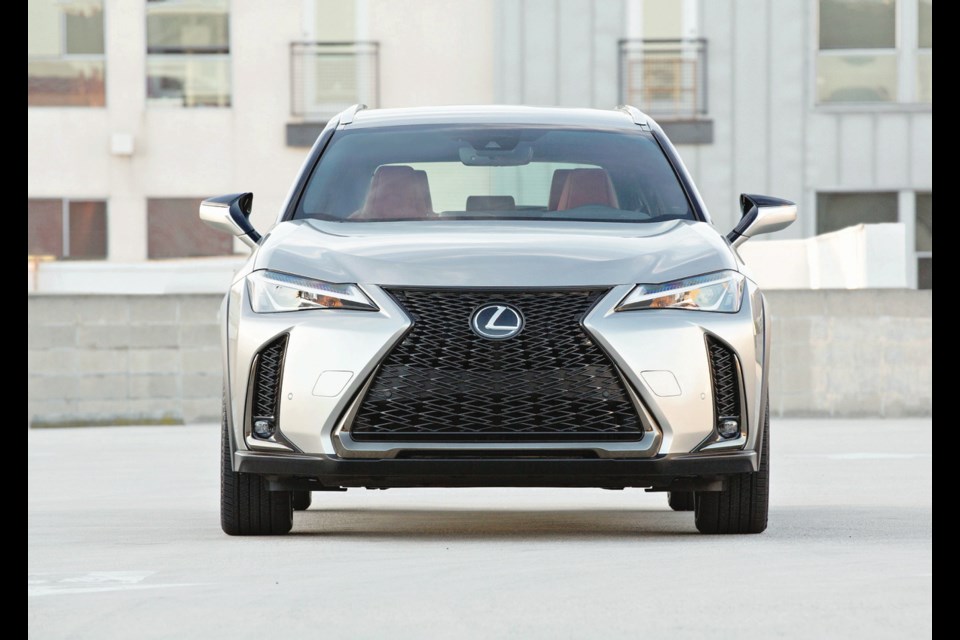There are still plenty of entry-luxury sedans to choose from, but the real action is in the utility segment, which is populated with taller vehicles that are mostly based on car platforms.
The new 2019 UX (the initials are derived from Urban crossover, or “X”-over) is the first Lexus to use Toyota’s all-new lightweight and extra-rigid Global Architecture platform. The Toyota C-HR also uses it.
The UX is therefore shorter than the larger NX wagon by about 13 centimetres. The distance between the front and rear wheels, however, is shy only about 2.5 centimetres, which works in favour of rear-seat passenger comfort.
The UX also follows Lexus’s current design philosophy, starting with an oversize spindle grille that absolutely dominates the front end. Like it or not, no one will ever question the brand.
The rest of the body is replete with knife-edge bumps and angles that extend all the way back to, and include, the rear hatch. The taillights are joined by a translucent red ribbon that appears to double as a spoiler. Subtlety is not in the UX’s playbook.
To keep the weight down, the doors, hood and fenders are made of aluminum, while the hatch is constructed of plastic-like composite material.
The interior layout is more restrained. There’s a central gauge directly in the driver’s line of sight, several redundant pushbuttons on the steering wheel and a total of nine switches on the instrument panel for the climate control.
The infotainment system is operated by way of a touchpad located on the centre console.
The standard six-speaker audio system can be upgraded to an eight-speaker setup. USB ports — two at the front and two for the second row — are available for all four passengers to charge their phones and tablets.
Protruding from atop the dashboard is a 25-centimetre touchscreen for the optional navigation system.
Since the UX is a small wagon, there’s not a lot of cargo space in back, but at least the three-section rear seat folds perfectly flat to maximize function.
The front-wheel-drive UX 200 has a 2.0-litre four-cylinder engine that puts out 169 horsepower and 151 pound-feet of torque.
Move up to the all-wheel-drive UX 250h hybrid and the 2.0-litre engine is augmented by three electric motors; two that directly assist the engine and a third attached to the rear axle to drive the rear wheels. Total system output is rated at 175 horsepower.
The 250h’s battery pack is located beneath the rear seat so it doesn’t affect the vehicle’s storage capacity.
The all-wheel-drive system only functions up to about 70 km/h. Beyond that point, it’s front-wheel-drive all the way.
Both the UX models use continuously variable transmissions, but the hybrid’s paddle shifters control 10 built-in “steps” that help create the sensation of a geared automatic.
Despite weighing about 135 kilograms more than its gasoline-only sibling, the hybrid is rated at 6.0 l/100 km in combined city/highway driving.
At a $37,000 base price ($39,000 for the hybrid), the UX arrives with a fair degree of standard equipment. That price also includes an array of active-safety technologies — such as emergency braking and pedestrian detection — but backup alert and blind-spot warning are optional.
Also optional for either model is anF Sport package that comes with sharper suspension tuning, unique grille and wheels, blacked-out trim, and sport-style front seats with added bolsters.
The F Sport doesn’t contribute to the UX’s over performance, but that’s not the point with this Lexus, which relies on economy of operation, fashion-show styling and affordable price as primary attention grabbers.
What you should know: 2019 Lexus UX
Type: Four-door, front- /all-wheel-drive compact utility vehicle
Engines (h.p.): 2.0-litre DOHC I-4 (169); 2.0-litre DOHC I-4 with electric-motor assist (175)
Transmission: Continuously variable
Market position: The new UX becomes the most affordable model
in Lexus’s tall-wagon lineup and competes with equally compact offerings from BMW, Audi, Mercedes-Benz and Cadillac.
Points: Edgy design is fast becoming a Lexus hallmark.
• Interior styling gives off a quality vibe.
• Base four-cylinder engine and the hybrid powertrains focus on fuel economy over performance.
• New continuously variable transmissions are built to perform more like multi-speed transmissions.
• Clearly built to entice more youthful buyers into Lexus showrooms.
Active safety: Active cruise control (std.); emergency braking (std.);
pedestrian detection (std.); lane-departure alert (std.)
L/100 km (city/hwy): 5.7/6.2 (hybrid)
Base price (incl. destination): $37,000
By comparison
BMW X1
Base price: $42,700
Second-generation model shares its mechanical components with Mini Clubman.
Cadillac XT4
Base price: $36,400
New-for-2019 small wagon runs with a 237-h.p. turbocharged I-4. AWD optional.
Infiniti QX30
Base price: $40,500
Compact wagon uses the Mercedes-Benz GLA platform and powertrain.



